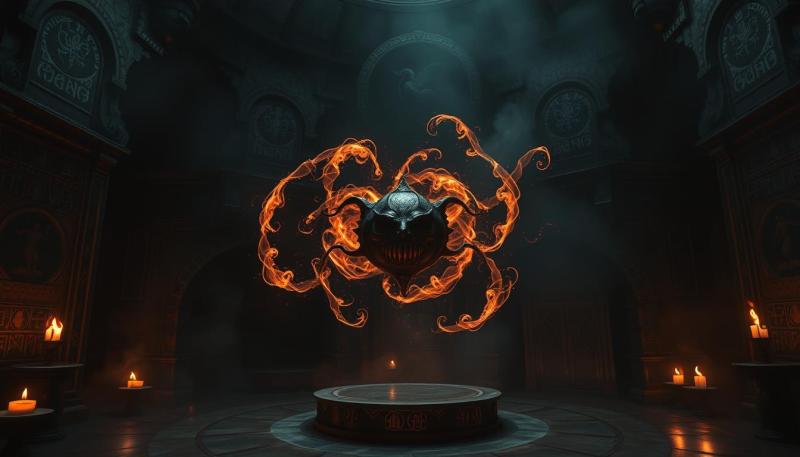Step into a realm where ancient legacies and aristocratic wizardry collide. For centuries, House Black has stood as a pillar of pure-blood tradition, shaping the wizarding world with its unyielding ideals. Their story isn’t just about magic—it’s a tapestry of power, pride, and secrets woven into the very fabric of magical history.
As part of the Sacred Twenty-Eight, this lineage epitomized elitism, blending mystery with unmatched influence. Their motto, "Toujours Pur" ("Always Pure"), wasn’t just words—it defined their identity. From grand estates to whispered political maneuvers, their impact still echoes in modern spellcraft and pure-blood culture.
You’ll discover how their 13th-century tapestry—a visual chronicle of alliances and disownments—symbolizes their relentless pursuit of purity. Names scorched from its threads reveal a family unafraid to erase even kin for their ideals. Yet beneath the grandeur lies complexity: a mix of ambition, loyalty, and contradictions that shaped generations.
Key Takeaways
- House Black’s legacy spans centuries, rooted in pure-blood supremacy and elite status.
- Their motto, "Toujours Pur," reflects a rigid commitment to magical purity.
- The family’s inclusion in the Sacred Twenty-Eight highlights their historical significance.
- Their ancestral tapestry at 12 Grimmauld Place serves as both record and weapon of exclusion.
- Despite fading prominence, their ideals continue to influence wizarding politics and culture.
Introduction to the Enchanting Wizarding Legacy
Behind every great wizarding tale lies a legacy shaped by fire and shadow. Take Sirius Black—the rebellious heir who defied his lineage’s dark values. His story, woven into the Harry Potter saga, shows how one man’s choices can ripple through generations. You’ll find his childhood home, 12 Grimmauld Place, hiding secrets in its creaking walls—a relic of power and regret.
This lineage wasn’t just about grandeur. Some members flirted with darkness, aligning with Death Eaters, while others clashed with the Ministry of Magic. Their ancestral motto, "Toujours Pur", wasn’t merely a phrase—it fueled feuds and fractures. Even today, their influence lingers in pure-blood debates and spellcraft traditions.
| Member | Role | Impact |
|---|---|---|
| Sirius Black | Rebel Heir | Defied dark alliances, aided Harry Potter |
| Bellatrix Lestrange | Death Eater | Symbolized family’s dark ties |
| Phineas Nigellus | Hogwarts Headmaster | Bridged old ideals with modern magic |
Explore their tangled roots through the Black family tree—a map of ambition and heartbreak. Names burned away tell stories of disowned witches and squibs. Yet amid the chaos, figures like Sirius remind us: even in the darkest houses, light finds a way.
History and Origins of the Black Family
Long before quills wrote their stories, whispers of a powerful lineage echoed through Europe. This family tree took root in medieval wizardry, blending ambition with an obsession for unbroken magical heritage. Let’s peel back the layers of time to understand how their legacy shaped—and fractured—the wizarding elite.
Early History and Mythical Beginnings
Picture 13th-century spellcasters trading whispers in candlelit halls. The earliest records show the family claiming descent from pure-blood families like the Peverells and Flints. Their rise wasn’t accidental—they married strategically, hoarded arcane knowledge, and built sprawling estates like Grimmauld Place.
What fascinates me? Their origin myths. Some texts suggest they bargained with mystical beings to “purify” their blood. Others say they erased squibs from their history so thoroughly, even portraits forgot them. One 15th-century scroll declares:
“No branch shall bear fruit unless nourished by magic’s purest springs.”
Modern Transformations and Disowned Branches
By the 1800s, cracks appeared. Rebellious members married Muggle-borns, triggering scorch marks on the ancestral tapestry. Take Cedrella Weasley—burned off for marrying into a “blood traitor” clan. Or Marius Black, erased simply for being a squib.
You’ll notice a pattern: their tree grew more twisted with each generation. While some joined wizarding reform movements, others doubled down on purity rituals. This tension birthed legends like Sirius Black’s defiance and Bellatrix’s fanaticism.
Their history isn’t just about power—it’s a cautionary tale. Even ironclad traditions couldn’t shield them from their own contradictions.
Family Tree and Notable Members
Unraveling their lineage feels like decoding a map of power and rebellion. At its core, the main lineage produced wizards who shaped history—for better or worse. Let’s meet the characters who defined this dynasty and the outsiders who quietly shifted its course.
Key Figures in the Main Lineage
Sirius Black’s defiance made him legendary, but his parents, Orion and Walburga, enforced purity with ironclad rules. Their portraits still scream insults at descendants in Grimmauld Place. Then there’s Regulus—Sirius’s brother—who joined Death Eaters but later betrayed them, a twist even the tapestry couldn’t predict.
Phineas Nigellus, the unpopular Hogwarts headmaster, bridged old-world elitism with modern politics. His portrait’s snide remarks in Dumbledore’s office remind us: pride outlives even death.
Magical Floating Candles with Wand - 20 Pack
Bring the enchanting ambiance of Hogwarts to your home with these charming floating candles and wand set
Product information
$41.89
Product Review Score
4.57 out of 5 stars
180 reviewsProduct links
Intriguing Relatives and Marital Connections
Marriages were chess moves here. Take Cedrella Weasley—burned off the tree for marrying into a “blood traitor” clan. Or Narcissa Malfoy, whose union strengthened ties to other pure-blood dynasties. Even disowned members like Marius (a squib) left gaps in the family’s “perfect” record.
| Name | Role | Legacy |
|---|---|---|
| Bellatrix Lestrange | Death Eater | Symbolized extremist loyalty |
| Andromeda Tonks | Disowned rebel | Married a Muggle-born |
| Cygnus Black | Pure-blood enforcer | Father of Bellatrix/Narcissa |
Notice a pattern? Every marriage either fortified their ideals or planted seeds of change. These connections didn’t just expand the tree—they tested its roots.
Blood Purity, Traditions, and Legacy
Imagine a code etched not in stone, but in blood. For generations, one phrase governed every alliance, ritual, and expulsion: "Toujours Pur" ("Always Pure"). This family motto wasn’t just decorative—it dictated lives. You’ll see how their obsession with purity shaped marriages, fueled feuds, and left scars on their legacy.

Family Motto, Rituals, and Pure-Blood Ideals
Picture this: newborn heirs swaddled in silver robes, their first breaths marked by an oath to the Sacred Twenty-Eight. The motto was woven into daily life through rituals. At age eleven, children pledged loyalty to pure-blood ideals using ancestral wands. Those who hesitated? Their names vanished from tapestries like smoke.
Marriages became political acts. Contracts specified "magical lineage verification" clauses, often enforced by goblin-witnessed vows. One 18th-century journal reveals:
"No daughter of ours shall wed without three generations of proven magic."
Disownments weren’t exceptions—they were policy. Squibs, Muggle-lovers, and reformers faced swift erasure. Yet even in exile, the motto haunted them. Andromeda Tonks, cast out for marrying a Muggle-born, later confessed: "‘Always Pure’ echoes in your bones, even when you reject it."
Their purity rituals left a contradictory legacy. While their bloodline dwindled, their influence seeped into wizarding law and social hierarchies. Today, debates about magical heritage still reference their extremes—proof that ideals outlive even the strictest enforcers.
Physical Descriptions, Wealth, and Social Status
Silver-haired figures glide through ancestral portraits, their sharp cheekbones and icy stares marking centuries of aristocratic refinement. The Blacks didn’t just wield power—they wore it. Their distinctive looks became a trademark: jet-black curls, porcelain skin, and eyes that seemed to dissect your bloodline at a glance. You’ll notice how these traits signaled noble status long before they spoke a word.
Distinctive Physical Traits and Aristocratic Elegance
Take Sirius and Regulus Black—brothers who shared the son’s burden of expectation. Both inherited the classic angular jawline and haughty posture, but Sirius’s rebellious grin contrasted with Regulus’s tense demeanor. Their mother Walburga’s portrait at home Grimmauld Place perfectly captures the lineage’s aesthetic: lips permanently pursed, as if smelling something foul.
These features weren’t accidental. Marriage contracts often specified “visual compatibility” to maintain their trademark elegance. A 19th-century diary entry reveals: “No heir shall wed unless their betrothed’s eyes mirror midnight skies.”
Financial Influence and Property Inheritance
Wealth flowed through their veins like inherited magic. The eldest son typically received home Grimmauld Place—a labyrinth of dark wood and cursed heirlooms. Younger heirs got vaults of galleons or overseas estates. This system ensured their status remained untouchable, even as the wizarding world modernized.
Regulus Black’s childhood bedroom—filled with silver-plated toys and rare spellbooks—shows how luxury reinforced ideology. Compare this to Sirius’s rejection of riches: he swapped silk robes for leather jackets, yet couldn’t escape the son’s legacy etched in his bone structure.
Their properties weren’t just homes—they were statements. When Narcissa Malfoy married into another pure-blood clan, her dowry included a 14th-century manor. As Walburga once sneered: “Our walls hold more history than most ministries.”
Insights into the black family magical world
Walk through any wizarding institution, and you'll find fingerprints of their ideology etched into its foundations. Their influence stretches beyond genealogy—it’s woven into laws, social norms, and even how we define magical excellence today.

Magical Influence in the Wizarding World
You might be surprised how many modern spells bear their touch. The Shield Charm refinement? Credited to a 17th-century member obsessed with pure-blood defense. Even Hogwarts’ sorting system echoes their belief in inherent magical superiority.
Their alliances with dark groups left deeper marks. A 2003 Ministry report noted:
“Blood purity debates still reference historical precedents set by elite dynasties.”
This isn’t ancient history—it shapes how somewizardsview half-blood legislation today.
Cultural and Social Impact on Magical Society
Ever notice how pure-blood weddings still use silver chalices? That tradition started with their marriage contracts. Over time, these customs became standard for many old-line wizards, blending prestige with exclusion.
The table below shows their lasting imprint:
| Aspect | Past Influence | Modern Echo |
|---|---|---|
| Education | Funded Hogwarts' Slytherin wing | Alumni networks favor pure-bloods |
| Politics | Lobbied for 1632 Magical Purity Act | Blood status debates in Wizengamot |
| Social Rituals | Introduced lineage verification | Heirloom wands at coming-of-age ceremonies |
Their role as gatekeepers made them an integral part of shaping wizarding hierarchies. Even reformers like Kingsley Shacklebolt acknowledge: “You can’t dismantle systems without understanding who built them.”
What fascinates me? How their contradictions endure. While modern wizards reject extreme purity laws, many unconsciously uphold traditions this lineage normalized centuries ago. That’s the paradox of legacy—it outlives its creators.
Names, Etymology, and Magical Symbols
Stars aren’t just celestial wonders here—they’re blueprints for identity. The practice of naming heirs after constellations and myths reveals how deeply this lineage tied itself to cosmic forces. Let’s decode the hidden meanings behind these carefully chosen labels.
Origins and Meanings Behind the Names
Take Sirius, derived from the Greek Seirios (“glowing” or “scorcher”). This fiery title mirrored his eventual rebellion against dark traditions. Then there’s Arcturus, named for the bear-guardian star—a nod to protecting pure-blood legacies.
Marriages often recycled these celestial titles to strengthen alliances. When a child received a name like Bellatrix (“female warrior”), it signaled expectations: loyalty to blood purity above all. Even disowned members carried symbolic labels. Andromeda, borrowed from Greek mythology, foreshadowed her fate: a woman cast out for loving a “lesser” partner.
Consider these striking examples:
- Regulus: Latin for “little king,” reflecting his role as heir
- Narcissa: From the self-obsessed mythological figure
- Cygnus: The swan constellation, symbolizing transformation
What fascinates me? How these names became spells of sorts—whispering destinies into each generation. A 1901 marriage contract even stipulated: “Firstborn sons shall bear stars; daughters, celestial guardians.”
Today, these choices remind us: in wizarding circles, a name isn’t just a label. It’s a compass pointing to heritage, ambition, and sometimes, rebellion.
Hufflepuff Alumni Seeker Adult T-Shirt - Gold
Show off your Hufflepuff pride in style with this comfy and eye-catching tee ideal for any fan!
Product information
$22.95
Product Review Score
4.35 out of 5 stars
20 reviewsProduct links
Conclusion
Legacies aren’t forged in stone but in the choices that ripple through centuries. The families who shaped wizarding history knew this best—their obsession with blood purity became both armor and shackles. Walk through home Grimmauld Place today, and you’ll feel the weight of that legacy: peeling wallpaper whispering forgotten oaths, portraits judging your every step.
From Bellatrix Lestrange’s fanaticism to quieter acts of rebellion, this lineage proves power lies in extremes. Their magic wasn’t just spells—it was influence woven into laws, marriages, and even how we measure worth. Yet their story also warns us: rigid traditions crumble under their own contradictions.
What endures? The families that adapt. While blood purity debates fade, echoes linger in heirloom wands and silver chalices at pure-blood weddings. Home Grimmauld Place stands as a museum to faded glory, its halls proof that even the mightiest dynasties aren’t immortal.
So here’s the question they leave us: Do we inherit legacies—or rewrite them? The answer, like their tapestry, remains beautifully unfinished.









